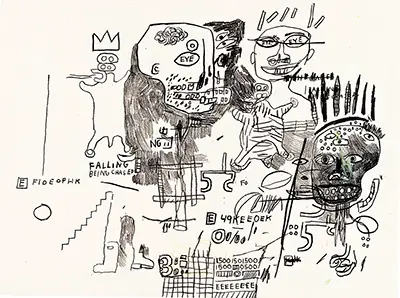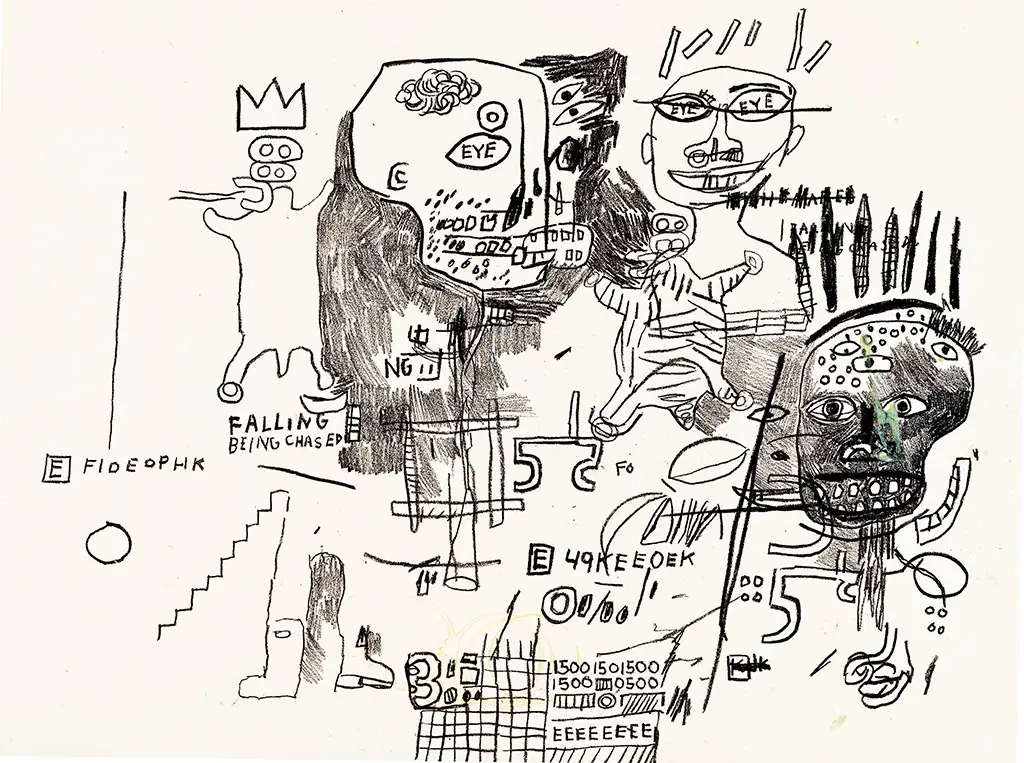The graffiti style is well suited to quick sketches, as was his work related to cartoons. Basquiat frequently produced figures out of single jagged lines, providing us with abstraction whilst still ensuring that the key elements of each scene were identifiable. The unconventional lifestyle of this artist meant that he would use all manner of materials on which to place his sketches - essentially, almost anything that was available at the time. This was a truly mixed media artist, using ink, pencil, felt-tip pens, markers and also acrylic pens in different combinations. In some cases he would even print out existing work and directly incorporate it into other paintings. His creativity was flexible, and artworks often became combined together as he experimented obsessively.
Artists over the centuries have produced sketched portraits of their friends and family to be presented as gifts, and Jean-Michel was no different in that regard. He produced several drawings of Rene Ricard, for example, though their relationship was at times turbulent. In modern times there has been a greater interest in the drawings of famous painters and sculptors, with Basquiat's being collected by keen followers plus others looking to make a good investment for the future. Many of these would be loose pieces, whilst most traditional artists would have made use of sketchbooks whilst travelling around different scenic locations. Basquiat was far less organised than that, as perhaps shown by his manic artistic style. He worked quickly, passionately, and not always with a clear end result in mind.
Many of the artist's drawings were never given an official title, such was his relaxed method of documenting his work. This has proven a common trend within modern art, where as those from earlier periods such as the Renaissance or Baroque eras would have spent many months, if not years, on individual pieces and, as such, would want to catalogue the work correctly. Many of Basquiat's pieces also speak for themselves, with very clear messaging on social issues such as racism, slavery as well as other items related to the Afro-Caribbean community in New York and the wider US. For the purposes of examining his career oeuvre accurately, academics have appended these titles with something related to each individual piece, as found in one of his most famous paintings, for example, of Untitled, 1981 (Skull). The artist spent considerable time within the artistic community of New York, which at the time was thriving - it was similar to the Parisien set of artists around a century earlier who had brought about the Impressionist movement as well as other later expressionist styles.
With the valuations on Basquiat's work rocketing in recent years, all items from his career have become particularly valuable. The increased exposure to artists from his cultural background has also increased the focus on this famous artist's oeuvre. This has meant that his drawings have also become both valuable and also highly desirable. The improved cataloguing of these should help us to eventually provide a comprehensive study of his work across this varied medium, and several publications have at least attempted to begin this urduous, but entirely worthwhile pursuit. Basquiat did not always feel comfortable being in the company of "stuffy" academics or art critics, but that has become an important factor to his legacy ever since his passing at a young age. They can now be of benefit to him, in protecting his achievements and avoid fraudulent individuals from passing their work off as his own. This, over a long period, could have the effect of diluting the quality of his work by placing imposters within it. This is especially possible within his drawings, where many were just a few strokes of the pencil and would be easier to mimic, but without the magical mind of Jean-Michel himself.
Whilst there remains a large number of original Basquiat drawings available for purchase from various high profile auctioneers, there are countless more fake items also in circulation. The official Estate for the artist have gifted its own signature to most approved drawings, normally on the 'verso' of the drawing. Those without these marks are not necessarily fake, but you should certainly then proceed with much greater caution. It would be fairly quick to produce copies of these drawings as opposed to, say, a highly complex Renaissance painting, and this makes Basquiat a popular target for fraudsters (the phrase "Buyer Beware" could not be more appropriate). His carefree lifestyle also means there was a disorganised cataloguing of his work, initially, though the estate have made great strides in providing a more concise list of his works. Alternatively, a far cheaper and safer options would be to select a Basquiat print from one of the licensed sellers available online. They focus most on his paintings, but some of his drawings are also available in printed copy form.



